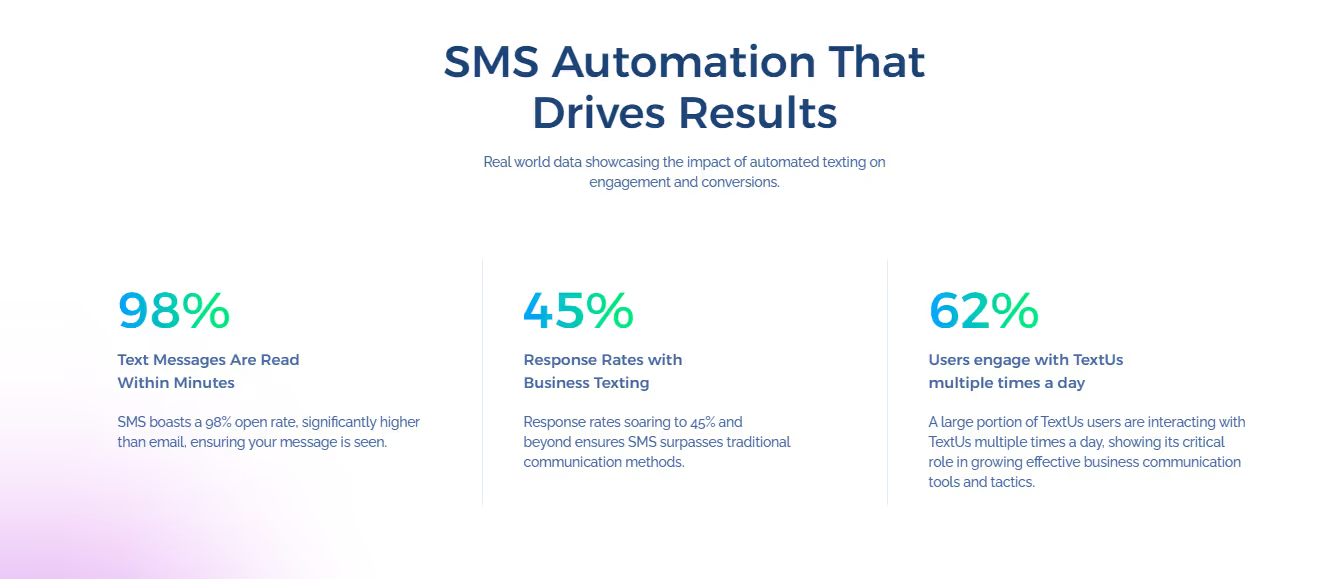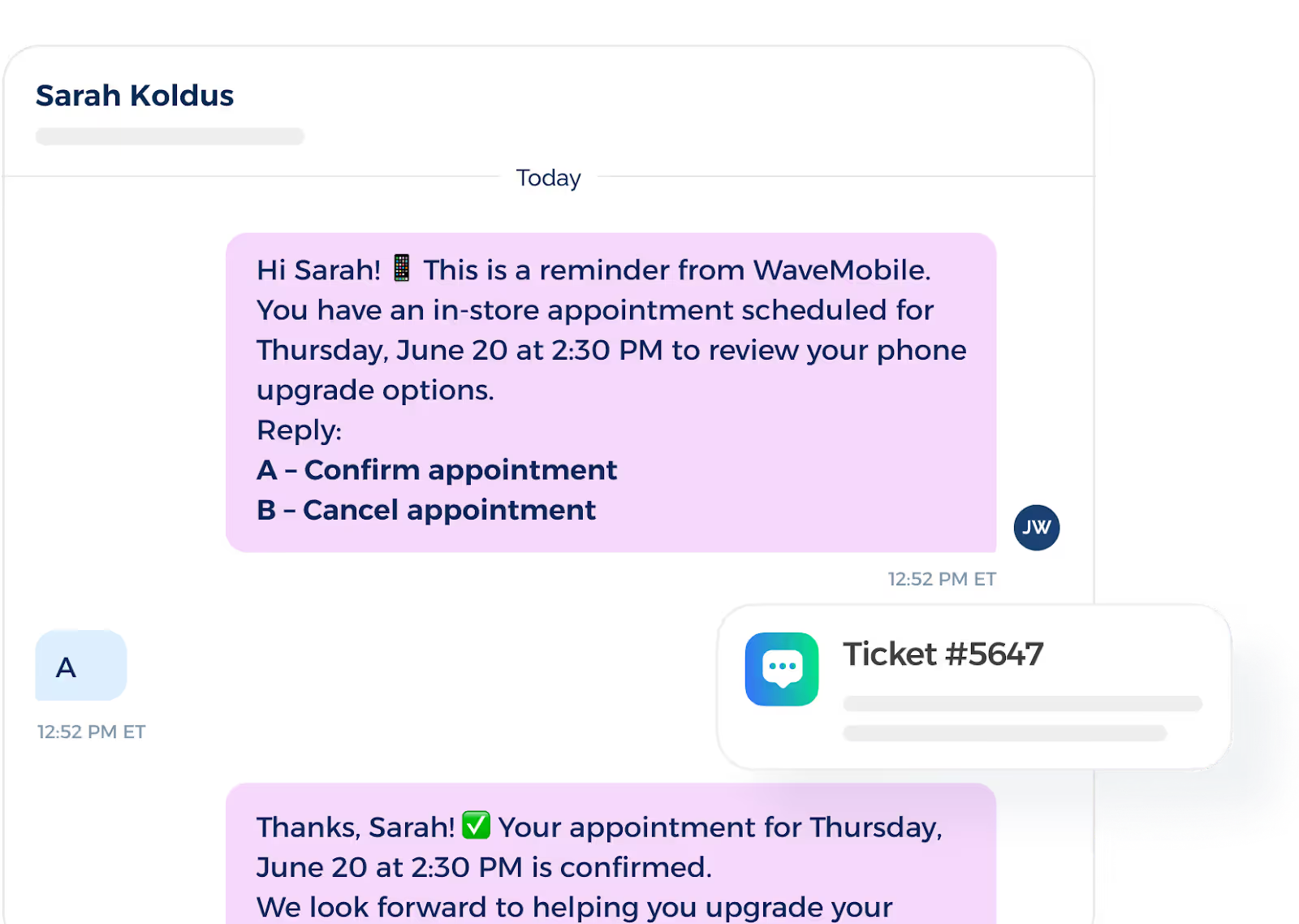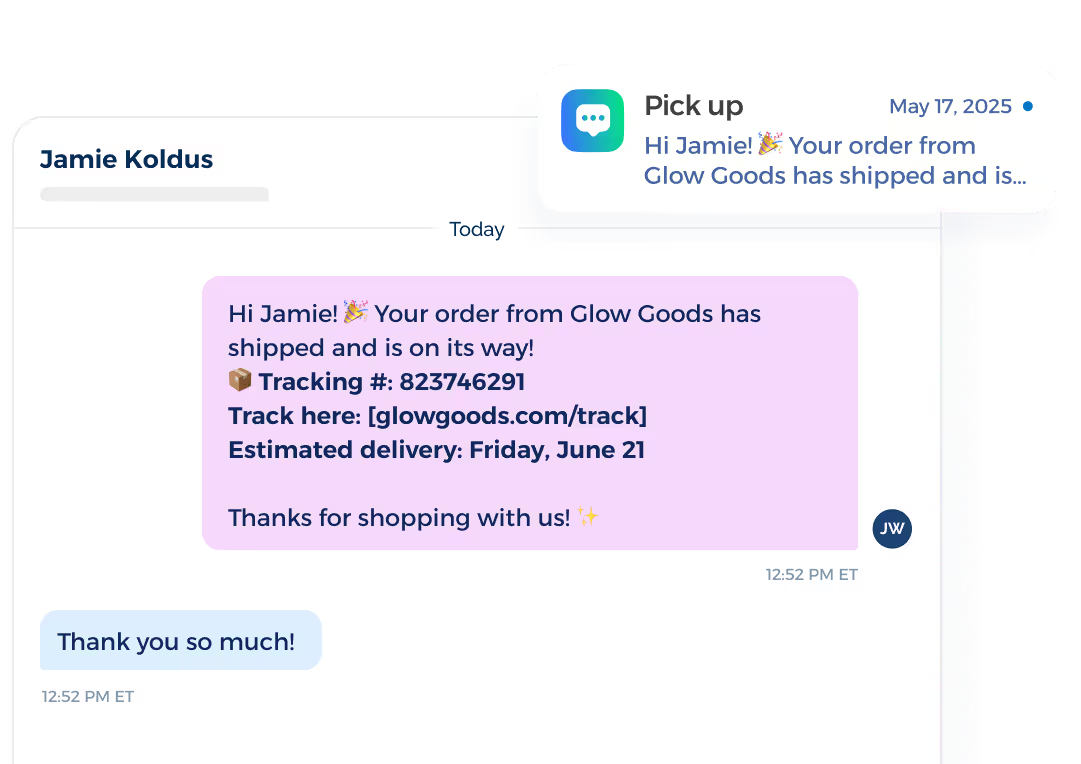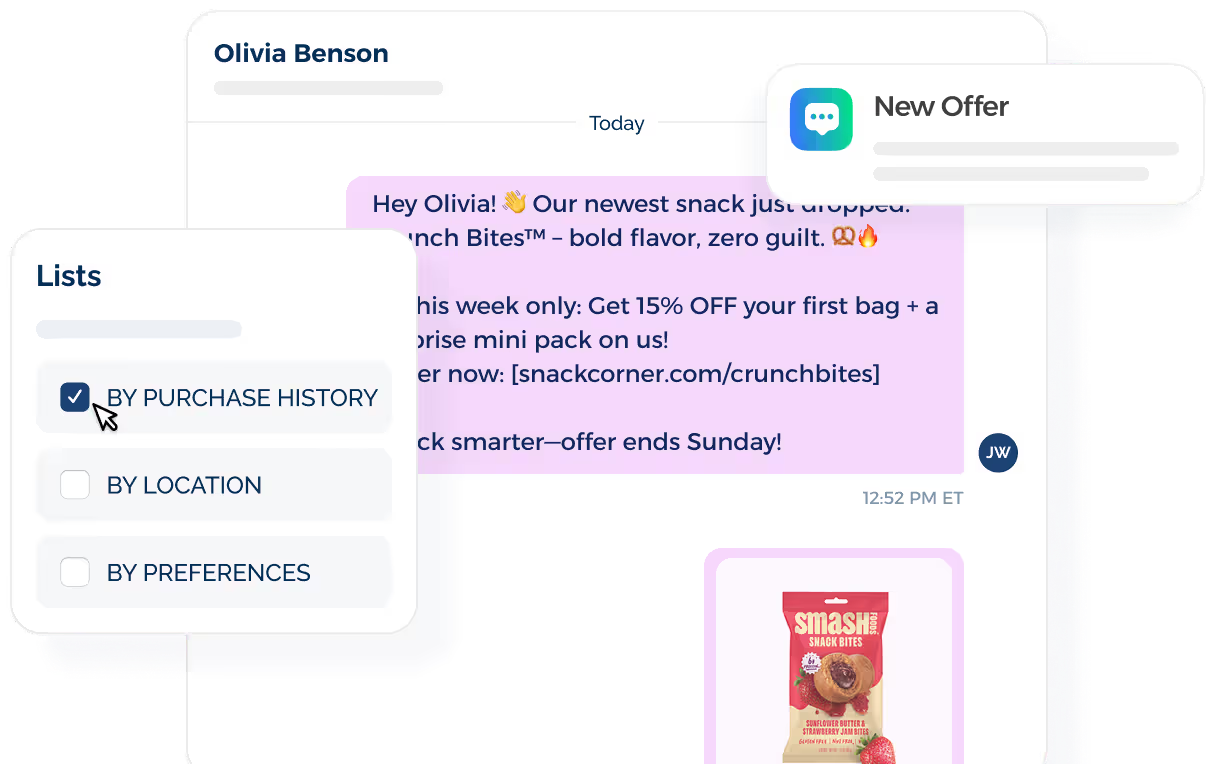8 SMS Marketing Automation Strategies to Boost Engagement
Explore eight SMS marketing automation strategies and learn how automation can improve your SMS campaigns. Discover how TextUs can help you.
Published
October 22, 2025

Most businesses know texting works, but few use it to its full potential. They still rely on manual messages or disconnected tools that make customer outreach slow and inconsistent.
With an effective SMS marketing strategy, you can finally fix that.
Automated workflows handle the timing and delivery, sending texts triggered by real customer actions. It’s the easiest way to stay connected and consistent while keeping communication personalized.
In this guide, we’ll explore the most powerful SMS strategy and automation techniques that can help you build stronger relationships and grow your business faster.
You’ll also learn how to personalize your messaging and use data to send texts that get results using the best texting software.
Why Use SMS Marketing Automation?
For most businesses, time is the one thing they never have enough of. SMS automation gives you a way to keep communication running without constant supervision.
Automation also helps you sound more personal. Research shows that 98% of all text messages are opened, which shows how reliable this channel is compared to email or social media.

Automated texts can be triggered by real customer actions such as signing up, booking a service, or finishing a purchase. Text messages always feel relevant rather than a random blast.
However, the biggest advantage is consistency. You will eventually lose touch with customers when you're just relying on memory or manual reminders.
With automation, you don’t need to worry about forgetting to send updates, thank-you notes, or promotions. Each interaction happens right when it should, keeping the relationship alive even when your team is busy on different tasks.
8 SMS Marketing Automation Strategies
The smartest SMS marketing strategy combines timing and personalization. Below are proven SMS marketing campaigns that you can use to keep communication consistent across every stage of the customer journey.
1. Welcoming New Subscribers
This is the first and most important step in any SMS automation campaign. It sets the tone for the customer relationship and immediately shows the value of subscribing.
When someone joins your SMS subscriber list through a form, website pop-up, or checkout page, they show interest. That moment of attention is when you should act.
Automating your SMS marketing campaigns lets you greet every new subscriber, no matter what time they sign up. A good welcome sequence can include one or two automated messages spaced over a few days.
- Day 1: The first text thanks them and includes a discount
- Day 2: The second shares a link to your bestsellers or tips related to your product
The goal is to keep it warm rather than pushy. People who just subscribed don’t want to be flooded with marketing messages. One friendly message is all it takes to make that happen.
2. Recovering Abandoned Carts
Few things hurt online stores more than full carts left unpaid. According to Baymard Institute, roughly 70% of online shopping carts are abandoned, often because shoppers get distracted or second-guess their purchase.
An abandoned cart reminder works best when it feels like a friendly nudge rather than a sales pitch. The goal is to remind customers of what they left without making them feel pressured.
The first message should go out soon after they exit or while their interest is still fresh. A second, lighter reminder can follow the next day if they still haven’t completed the purchase.
Here’s an example of an automated SMS that strikes the right tone:
- “Hey! You left something behind. Complete your order today and get free shipping—it’s still waiting in your cart!”
- “We saved your cart for you. Checkout within 24 hours to get 10% off your purchase: [link]”
- “Your items are still available. Grab them before they sell out. Tap here to finish your checkout: [link]”
The tone and timing of your business SMS make all the difference. Sending too early feels aggressive, while sending too late makes the reminder useless.
The best SMS marketing automation strategy for cart recovery is to personalize the message and make it easy for the customer to act. You can include a direct link to their cart and, occasionally, a small perk to spark action.
3. Following Up After Purchases
Once a sale is complete, many businesses make the mistake of going silent. That silence creates distance, while a thoughtful follow-up keeps the relationship alive.
The first message should always express gratitude. A simple “Thanks for your order!” shows acknowledgment and professionalism. This can be followed by messages that add real value, such as shipping updates or product care tips.
Example
- “Your skincare kit is on the way! Want to get the best results? Check out our quick-use guide here: [link]”
- “We appreciate your purchase. Here’s 15% off your next order as a thank-you for shopping with us: [link]”
- “Thank you for your order, Mia. Your items are being packed and will ship soon. Track it here: [link]”
Automation helps time your automated text messages perfectly. The first goes out right after purchase, and another can follow after delivery to ask for feedback or a quick customer survey.
Over time, consistent post-purchase texts improve customer engagement, which impacts repeat sales and referrals.
4. Re-Engaging Inactive Customers
People change habits, switch brands, or simply forget to check back. Automated text messages are designed to bring inactive subscribers or past buyers back into the loop.
The key is to remind customers why they liked your brand in the first place. You can send personalized messages acknowledging their absence. You may also offer something worth returning for, such as a new product, a small discount, or exclusive early access.
Examples
- “We haven’t seen you in a while! Come back and enjoy 15% off your next order—only this week!”
- “Still part of the [companyName] community? We’ve launched new self-care bundles. Take a look before they sell out: [link]”
- “We miss you at [companyName]. Come back this week and enjoy 20% off your next coffee bag, just for you: [link]”
The best re-engagement campaigns don’t rely on discounts alone. They also update customers on what’s new or improved within your SMS marketing program.
You could mention a new collection, better delivery options, or fresh content on your site that aligns with your marketing efforts.
5. Celebrating Birthdays and Anniversaries
People remember small gestures, and few gestures feel more genuine than being acknowledged on their birthday or a meaningful date.
Birthday and anniversary SMS marketing messages build warmth and loyalty. Not because they sell something, but because they show that your brand pays attention.
A short, thoughtful birthday greeting with a reward or discount gives customers a reason to smile and engage. It also encourages them to make a purchase they might have postponed, which improves the overall customer experience.
- “Happy Birthday, [name]! We’re celebrating with you—enjoy 15% off any purchase this week: [link]”
Anniversary texts can work just as well. You can mark a customer’s first purchase, subscription date, or membership start date to strengthen long-term relationships.
- “It’s been one year since you joined the [companyName] family! Thanks for sticking with us. Here’s 10% off your next renewal: [link]”
Automation tools within your SMS marketing software make scheduling and timing effortless. Once a customer’s date is in your system, messages can be sent automatically every year, perfectly timed and always relevant.
6. Sending Appointment Reminders
Missed appointments drain revenue and frustrate teams. SMS marketing automation solves this by confirming bookings the moment they’re made and sending smart reminders before the visit.
A solid flow covers three moments: right after booking (confirmation), one day before (reminder), and day-of (final nudge). Each message should be action-ready so people can confirm, reschedule, or ask a quick question without calling your front desk.
Two-way texting is key here. It lets customers receive SMS messages and reply quickly with a single letter or keyword, so they don’t abandon the task. You can also use simple routing rules to reduce back-and-forth.

Examples
- Confirmation (instant): “Hi [name], your [service] is set for [date] at [time] at [location]. Add to calendar: [link]. Reply C to confirm, R to reschedule.”
- Reminder (24 hours): “Reminder for [service] on [date] at [time]. Reply C to confirm, R to reschedule, STOP to opt out.”
- Day-of (2 hours): “See you at [time] today. Directions: [map_link]. Questions? Reply HELP.”
You may tie this logic to your calendar or practice system so open time is filled fast. You should also make sure to track a short list of metrics so you can tune the flow instead of guessing.
7. Running Limited-Time Promotions
The urgency of a short deadline can turn a casual subscriber into a paying customer faster than most other marketing channels.
The goal here is to create excitement without sounding desperate. Each message should be short and time-sensitive and include a clear call to action that fits within your marketing efforts.
Phrases like “today only,” “ends at midnight,” or “first 100 customers” give a natural sense of urgency. However, consistency matters. If every campaign screams “urgent,” customers will start to tune out.
Examples
- Early access offer: “Early access just for you. Shop our weekend sale now—20% off everything until midnight tonight: [link]”
- Mid-sale reminder: “Quick reminder—our fall sale ends tomorrow! Save 15% on all items before prices go back up: [link]”
- Final call message: “Final hours to save! The sale ends at midnight. Don’t miss out on free shipping before it’s gone: [link]”
When planned correctly, these time-sensitive messages can create a steady flow of engagement without exhausting your audience. They work best when used occasionally, supported by genuine value and clear communication.
8. Automating Customer Support
Customer support is usually where businesses win or lose trust, and SMS marketing automation now plays a major role in that space.
Texting gives customers a faster, more natural way to ask questions, confirm details, or get help without waiting on hold or digging through emails. This improves the customer experience and strengthens your SMS marketing program overall.
Automation can handle the first layer of responses by acknowledging requests, routing messages, or providing instant answers. Meanwhile, human agents step in only when needed.
For example, when a customer texts “order status,” an automated system can instantly reply with their tracking link. When someone texts “cancel appointment,” the system can update the booking and send a confirmation.

These quick actions save time for both sides and cut down on repetitive tasks that typically slow support teams down. Here’s a simple setup that you can implement for your business:
- Auto-reply for common questions: Set up responses for frequent messages like “hours,” “address,” “shipping,” or “pricing.”
- Ticket routing: Direct complex inquiries to the right team or representative automatically.
- Escalation rules: If the system doesn’t recognize a question, forward it to a live agent immediately to avoid frustration.
- Follow-up messages: Send a thank-you text after a resolved issue or a survey link to rate the support experience.
TextUs makes it easy to combine automation with real-time chat. Fast automated responses with human backup create a seamless experience whenever they reach customer service.
Automated support flows can dramatically reduce response time, lower support costs, and improve customer satisfaction. Smart automation doesn’t replace your support team; rather, it helps them focus on what requires immediate attention.
Do You Need Personalization in SMS Marketing?
Personalization is the difference between a message that gets ignored and one that gets a reply.
In business SMS marketing, personalization starts with understanding your audience. Every customer behaves differently. Sending everyone the same message misses the mark.
In fact, people notice when brands get it wrong and they don’t like it. An Epsilon survey found that 76% of respondents view brands negatively when they include inaccurate information about them in their advertising or messaging.
Automation makes it possible to send SMS messages that feel personal without losing authenticity. It allows you to trigger messages based on behavior, such as a purchase or browsing history.

These small touches feel personal but take no extra effort once the system is set up. When messages connect with what the customer wants, conversions rise naturally.
How to Segment Your Audience for SMS Marketing Automation
Instead of sending one blanket message to your entire list, segmentation lets you group subscribers based on shared traits or behavior. This creates targeted communication that leads to fewer SMS opt-outs, stronger engagement, and more sales from the same audience.
The most common way to segment your SMS list is by demographics, like age, gender, or location. This helps tailor offers to what fits each group.
For example, a retail brand could text “winter jacket” promotions to customers in cold states and “beachwear” deals to those in warmer ones. Time zones are another simple but important layer, as nobody wants to get a promo text at 2 a.m.
Another smart approach is behavior-based segmentation. This groups people according to their actions:
- New subscribers can get a welcome discount or brand introduction
- Frequent buyers can receive early access to new releases
- Inactive customers can be re-engaged with a win-back offer
You can also segment by purchase history or customer preferences. A pet store, for example, might send different SMS campaigns to dog owners and cat owners. A salon might remind men and women of different services.
Automation platforms make this process easy by syncing customer data from CRMs, ecommerce systems, or past campaigns. Once your SMS segments are built, you can set automated flows for each group without needing to recreate campaigns every time.
Why Choose TextUs in Automating Your SMS Campaigns
If you’re serious about using text message marketing to reach more customers and close more deals, TextUs makes it simple. It combines SMS marketing automation with real-time conversations and CRM integration so your marketing text messages never feel off-target.

Build a Stronger Sales Pipeline
TextUs gives you a simple way to turn SMS marketing efforts into a steady source of new leads. Rather than juggling separate tools or trying to send messages one at a time, you can create automated workflows that build relationships and improve consistency.
This SMS automation platform supports large-scale campaigns without limits on contact size, so you can reach your SMS list effortlessly. You can also set up automated drip campaigns or trigger transactional messages to remind customers about upcoming events, purchases, or renewals.
Campaigns can include rich MMS messages and branded links that stand out on mobile devices, increasing click-through rates and engagement.
Each automated texting service flow runs continuously, freeing your team from repetitive tasks while still sending personalized messages based on behavior and timing.
Boost Customer Engagement
What separates TextUs from other messaging tools is its focus on conversation, not just delivery. It combines the reliability of automation with the flexibility of real-time texting.
Your marketing and sales staff can work from anywhere using the desktop dashboard, mobile app, or Chrome extension within the CRM. They can send SMS directly, manage multiple messages, and collaborate using shared inboxes.
Ready-made templates make it easy to send automated text messages without sacrificing tone or brand consistency. Each campaign follows A/B testing principles to find the right message, adjust message length, and maintain strong performance across all devices.
Gain Insights for Better Campaigns
Beyond automation, TextUs gives you valuable insights into performance. The built-in reporting shows exactly how many messages were delivered, opened, and responded to. You can monitor key metrics like customer acquisition cost, response rates, and customer lifetime value.
Interactive dashboards make performance tracking easy to understand at a glance. Each chart helps you see where your audience responds strongest and where to make improvements.
Seamless CRM Integration
One of TextUs’ biggest advantages is how it connects with popular customer relationship management (CRM) systems such as Salesforce, HubSpot, and Microsoft Dynamics.
Your marketing and sales teams can send, receive, and track text messages directly within their existing workflows.
Every message is logged inside the CRM to provide complete visibility into past interactions and help teams stay coordinated. With TextUs built into your CRM environment, you can launch, monitor, and manage SMS campaigns without switching platforms.
This integration brings structure to communication, reduces missed follow-ups, and creates a more organized marketing process from start to finish.
Turn SMS Into Your Top Marketing Channel—Try TextUs!
If you’re ready to turn texting into a real growth engine for your business, TextUs gives you everything you need to make it happen.
With its simple-to-use automation tools, you can create campaigns that run themselves. From welcome sequences and reminders to re-engagement campaigns, TextUs helps you stay connected to your audience without the constant effort.
TextUs also lets you combine real-time two-way conversations with powerful data insights. You can set triggers, schedule messages, and manage your entire contact list from your CRM. Every message you send is on-brand and helps you boost overall conversions.
Don’t let your marketing stop at email or social media. With TextUs, you can build smarter workflows and scale your communication without losing that personal touch.

Book a demo with TextUs today to bring these SMS marketing automation strategies to life!
FAQs About SMS Marketing Automation
What is SMS marketing automation?
SMS marketing automation is the process of sending text messages to customers automatically, based on specific triggers or schedules.
Automation tools allow you to set up workflows like welcome messages, reminders, or follow-ups that run on their own. This saves time while keeping communication personal and consistent.
How to automate SMS messages?
You’ll need a tool that supports text message automation and follows industry best practices.
SMS marketing platforms like TextUs make it easy to set triggers, schedule recurring messages, and send tailored messages. This keeps customers informed without sending too many messages.
Automation also ensures text message compliance by collecting explicit consent from subscribers before sending marketing texts. You can design automated flows for loyal customers, new sign-ups, or transactional updates to keep engagement consistent.
Is SMS marketing 98% open rate?
Yes, studies confirm that mobile marketing consistently outperforms other channels, with open rates around 98%.
This is far higher than email, making SMS ideal for transactional SMS, promotions, or reminders. Messages are read within minutes, which helps you stay visible to your audience.
What are the top seven types of digital marketing strategies?
The top seven types of digital marketing strategies most businesses use include:
- SMS marketing automation: Sending personalized, timely messages to customers through text
- Search engine optimization (SEO): Improving visibility on Google
- Content marketing: Creating valuable articles, videos, or guides
- Social media marketing: Building brand awareness and engagement on platforms like Facebook, LinkedIn, or Instagram
- Email marketing: Nurturing relationships through direct inbox communication
- Pay-per-click (PPC) advertising: Buying targeted traffic through ads
- Affiliate marketing: Partnering with others to promote your products
Continue Reading
Frequently Asked Questions
Business Texting
Built for Results
Create and convert pipeline at scale through industry leading SMS software




